
Mike Sanderson on the Volvo Ocean Race
Given the carnage on the opening leg of this Volvo Ocean Race, combined with the shorter stopovers, it is a miracle all six boats are rearing to go for tomorrow’s Pro-Am, prior to Saturday’s Cape Town In-Port race and the start of leg two on Sunday to a preliminary destination unknown.
For Mike Sanderson, skippering Sanya, the former Telefonica Blue and the only old generation boat in the race, this Volvo Ocean Race didn’t quite have the start he’d hoped for. A collision on the first night out of Alicante, saw Sanya nearly sink, but her crew managed to make port and the boat, like Abu Dhabi Ocean Racing, was subsequently shipped to Cape Town. In South Africa, boatbuilders were assembled to knock up a new bow and have since been working in record time to fit it.
“The boat came off on the ship only last Wednesday and we launched it yesterday,” recounts Sanderson. “We put the rig in the morning and went sailing this afternoon. So it was a pretty miraculous turn around. It just took a week - the guys did an awesome job.”
They ended up cutting out a section of the underside of Sanya’s bow about 5m long by 3.5m wide by 1m high, so it was lucky that the boat builders had, using a male mould, had made the replacement section with an extra 1m all round.
With the new underside of the bow fitted, Sanderson reckons they have probably gained only around 24kg due to additional taping and fairing. “In the old days that would have been a double hit, it would have come off the bulb, but now it doesn’t. They have a rule that if it is a mod of less than 35kg, it doesn’t require an instant reweigh. We were inside, which was pretty convenient.”
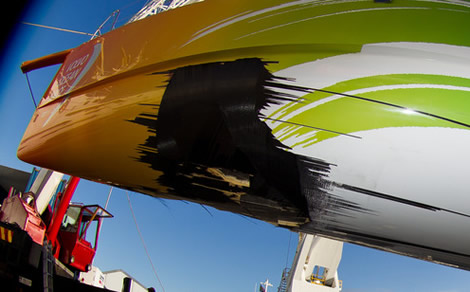
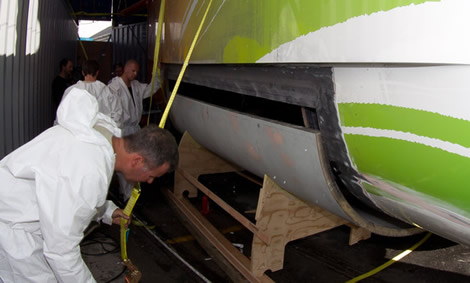
Another concern for Sanderson came on the same first night out of Alicante when Abu Dhabi Ocean Racing dismasted. Both she and Sanya are the only two boats of the six to have masts from Future Fibres’ new sparmaker, Future Spars.
“At the time it caused us quite a lot of concern, but basically as they did more and more testing, and dug deeper into what had gone on there, we are now at a stage where we are very comfortable,” says Sanderson. “The guys now know a huge amount about the rigging system and about the rig and I really can’t fault the effort they have gone to, to make sure it doesn’t happen again.”
Abu Dhabi Ocean Racing’s rig broke when a checkstay snapped when they came off a wave. “I can only assume that that caused the rig to over bend and something else must have given way due to the dynamic loads that were suddenly imposed on it,” says Sanderson. “Knowing the sea state that was out there and knowing what the boats go through in that stuff, if your checkstay broke it is probably 50-50 whether your rig stays up - no matter what any design model tells you and those guys were on the unlucky side of that.”
As a result they have made a couple of modifications to some of Sanya’s rigging attachments, but Sanderson maintains this is more a result of the extensive testing carried out by Future Fibres post-dismasting rather than a knee-jerk reaction to the dismasting itself.
As mentioned Sanya is the former Telefonica Blue and despite modifications to the VO70 rule, the boat has managed to enter this Volvo Ocean Race with a grandfathered keel, potentially 200kg heavier than what the rule now permits.
“We weren’t allowed to modify the hull if we wanted to keep the grandfathered keel,” says Sanderson. “But to be honest Telefonica had done most of the work.” In the last Volvo Ocean Race Telefonica Blue had suffered two groundings – the first leaving Qingdao, the second off Marstrand. Telefonica replaced the keel soon after the end of the last race. “They went for a new Farr bulb and they retrimmed the boat at that time, which is what we are running now.”
So compared to the original Telefonica Blue configuration, the bulb is now further aft on the foil, and the mast has more rake in it – up from 2.5deg to 4.5. Sanderson says that as a result her light airs performance is reduced, but Sanya is now much quicker reaching and downwind.
Despite having a potentially heavier bulb Sanderson says that in comparison with the new boats the weight increase has only effectively gone from the fin to the bulb. “It was supposed to be our golden arrow, but it hasn’t turned out to be quite as much as the organisers had hoped from an advantage standpoint. That is a shame, because if we could have been a tad more competitive I think that would have been great for the future.
“We are the heaviest boat now, even though she was the lightest boat then. They haven’t got it quite right, because they are measuring quite a lot more equipment on board than they did with the old rule. Measurement weight we are there or thereabouts, but in terms of overall sailing weight we are probably 200kg heavier.”
Sanderson hopes that if they can put in a good performance in this race as their budget is around half that of the teams with new boats, and this might encourage more teams to enter older generation boats in future races.
In terms of new gear on board the spar and rigging is obviously new. The daggerboards were replaced and she has new sails. Back in June this year, Sanderson bought into Doyle New Zealand and Australia, working alongside the legendary Richard Bouzaid. So, no surprises, Sanya is fitted with Doyle sails.
“The big question is how the Stratis technology will be versus 3Di from a durability standpoint. From what we are seeing our sails have come out lighter and we are very happy with how strong they are, but let’s see half way around the world,” says Sanderson. Stratis are laminated sails, built on a flat table and subsequently shaped, rather than being laminated on a mould like 3DL or laminated like you might build the hull of a yacht, only with ultra-fine tapes, which is the process with 3Di.
“From a durability standpoint, the ability to laminate at very high pressure makes them pretty durable. So the trade-off is: do you want to laminate at high pressure or do you want a moulded shape? The Doyle argument is that there is only 70mm of broad seam in a Volvo 70 main, so we are taking the lamination game.”
Carbon is banned in Volvo 70 sails, so typically Kevlar or Spectra or a combination is used. On Sanya, Sanderson says their sails are all Kevlar, expect that they have developed a black Kevlar, which has a carbon look.
“For me sailmaking is more about who are the good designers. Richard Bouzaid designs all our sails and he is one of the few people in the world who has won both the America’s Cup and the Volvo race. He is a great sail designer. I would sure prefer to have great sails designed by Richard rather than having picked up whoever was left of the North designers.”
As mentioned in previous articles about the new Volvo boats (see all this here), the size of sail wardrobe is limited in this race, making the choice of sails even more important, in particular tight luff versus flying luff on the second masthead kites. Sanya, as well as Abu Dhabi, has both gone for top down furling systems (as developed on Karl Kwok’s Farr 80 Beau Geste) and as a result they should be able to make these sails deeper than the tight luff sails.
Form
Prior the start Sanderson had said this Volvo Ocean Race was ‘Puma’s to lose’. “They have got a boat with great pedigree. It is second time through for their management structure and set-up. That is quite a big advantage. They have Brad [Jackson] and Tony [Mutter] who I am obviously a big fan of. They were both instrumental in ABN’s victory and then in Ericsson’s. Puma for me are the favourites.”
However Telefonica was a close second. “There is no doubt that Telefonica have a great team and they have got some very fast sailors and a very fast boat. Definitely if I was picking a boat, I would pick either her or Puma. I have openly said if I was the others I would be disappointed how competitive they were in the light, because I think they are going to be very hard to beat reaching in breeze.”
Sanderson believes this latter feature is what makes the difference in the Volvo Ocean Race. “Since it went VO70, it is the high speed stuff where the race is won and lost, and for me the Juan K boats look very strong, they look ready to do 25 knots. I think the one which is the most left field is Camper. I have no idea about that, apart from the fact that I remember having conservations like this when Team New Zealand’s TP52 came out and we all know what happened there! ‘That’s a bit different. That’s not going to work!’ But sure enough...”
Pre-race Sanderson’s concerns were over whether Camper was strong enough power reaching. Unfortunately leg one didn’t really prove this one way or the other as by the time these conditions arrived Camper was in a different part of the ocean.
As to the issue of Camper’s forestay, Sanderson says he struggles with it. Ironically after the last two races where the rules makers were also the rule arbitrators, for the present race this has changed with interpretations of the rule now made by the Rule Interpretation Group, led by renowned America’s Cup designer Andy Claughton.
“Have they been interpretations of the intent of the rule? Definitely not,” says Sanderson of the rulings so far made on whether the Kiwi/Spanish boat has an adjustable forecast or not. “But as interpretations of what is written, they are probably pretty fair. The grey area for me is that I don’t believe that the interpretations that came out ever allowed them to sail with it upwind and we are going to know what the jury thinks of it with Groupama’s protest. For sure they are using it to adjust rake, just like on a TP52. You can’t see the ram but it is there and it must be a big ram, because it is happy to take full forestay load.
“I am a bit surprised because that is not going to win them or lose them the race. We had it with Speedboat [Rambler 100] and with Pindar [IMOCA 60] and it does less than we thought it would, which is why Rambler pinned it and why Brian pinned it. So I am surprised that they kept pushing that barrow.”
Groupama currently has an outstanding protest against Camper over their forestay issue which is due to be heard tomorrow afternoon (Friday) at 1600 local time. So watch this space.
As to being back in the Volvo Ocean Race, after sitting out the last race when he was running TeamOrigin, Sanderson is clearly relishing being back. “You forget how cool the VO70 is. You sail around in other things for a while and you get back on a VO70 and 25 knots at 100TWA reaching and it is like ‘holy shit’.”
Like the AC45s and 72s, the VO70s are high performance boats that are purposefully difficult to sail, as opposed to French boats like the IMOCA 60s and maxi-tris where strides are made to make these difficult boats as easy to sail as possible.
“It is interesting talking to the French guys. Thomas Coville [sailing on Groupama] goes ‘this is bullshit compared to sailing my 100ft tri when I am up out of the water, I am walking around in 25 knots and because I am up in the air, it is a little bit cold, but I am dry, I am level, etc.’ But the amount of water that is coming over the VO70s now – it is bullshit. The 2005-6 race proved that guys do get washed down the deck. But Moto GP’s ratings will have gone up and Indy car’s ratings will too – it is a terrible thing, but people want action.”
Prior to the start of the race Sanderson was waxing lyrical about the reliability of the new generation boats. “On ABN AMRO everyone was exploding around us and we managed to keep it one piece, but it felt like we were sailing on a ticking bomb a little bit...” However even in the 2005-6 race they were often pushing to the limit. Sanderson recalls coming into Cape Horn when ABN AMRO One and movistar were sailing at 600 mile/day speeds which only ended when movistar broke.
This time about the only time Sanderson reckons they will slow down is upwind or in extremely lumpy seas (as they encountered on the boat breaking first night). “It is a bit scary this time because, it is a bit like the last race of the Volvo 60s when everyone was just ringing their necks. I think it is getting more and more dangerous in a VO70 because the reliability is going up, the pace is going up, so more water is going over the deck. The other thing which has happened this time is that we always used to have a flying fractional spinnaker, the A6, and there was quite a nice home for that at 30-35 knots when you were cruising around downwind. Now you have a fractional Code 0 on and you are bow up and you are Mach-2-with-your-hair-on-fire kind of thing. You are apparent wind angle sailing and you are up at 65-70 AWA. Due to the lack of sails, we have to sail in that mode.”
Previously they use to go from the A4 to the A6 and then to the fractional Code 0, but using it at a deeper angle, more like a spinnaker with the boat less heated up.
With the measures the organisers have introduced which it is hoped will prevent Volvo Ocean Race crews being held captive for ransom in some remote mountain region in Somalia during the next two legs to Abu Dhabi and then on to Sanya, so it seems that for much of the next two legs, the VO70s will be travelling by ship.
Sanderson says that if the route of the Volvo Ocean Race hadn’t changed to visit the Middle East and Far East, then it is likely there would no Volvo Ocean Race any more. “It is either love it or leave it - just a sign of the times.”
However it sounds like they will get a good sail in for the first part of this next leg – around two weeks at sea by Sanderson’s reckoning. And it sounds like leg 2 will stop at the same place where the main part of leg three will start, thereby quashing critics who maintain that the Volvo Ocean Race is no longer ‘round the world’.

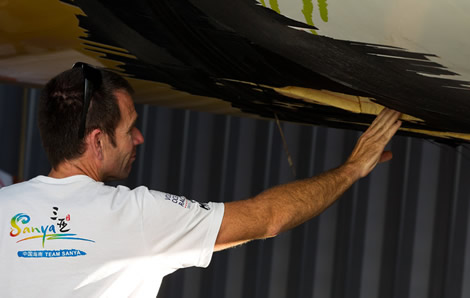
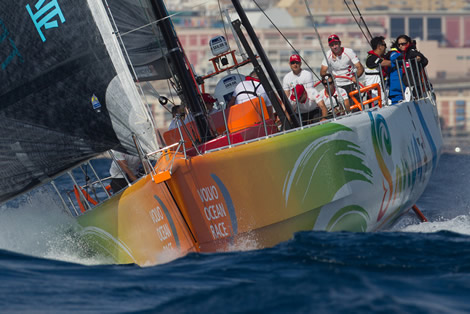

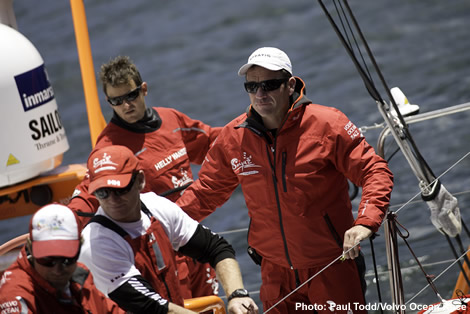

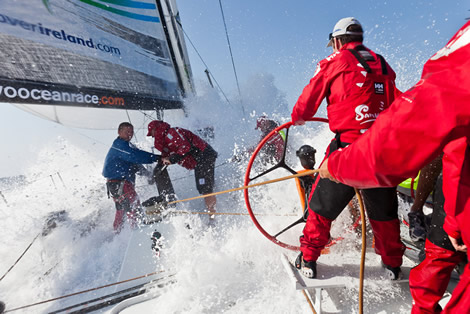









Latest Comments
Add a comment - Members log in